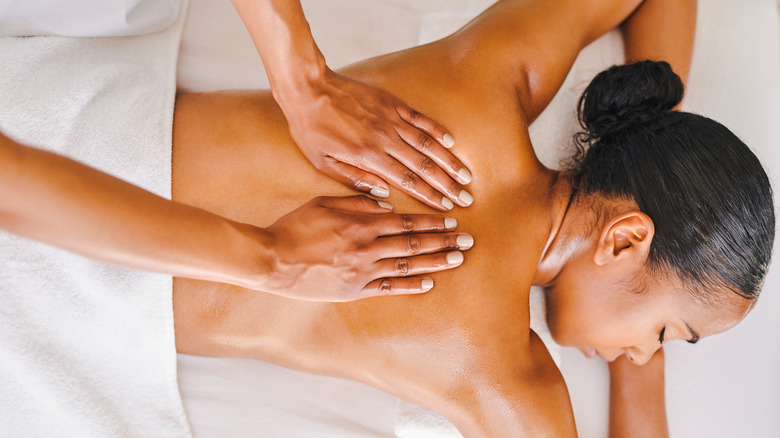Does The Controversial Biting Massage Actually Have Wellness Benefits? We Asked A Physician
Strange, celebrity-approved therapies are nothing new. From the star-driven hubbub around the PRP vampire facial to the better-left-forgotten penis facial, we've seen a lot of strange spa treatments come and go. But have you ever considered letting a masseuse bite you?
Celebrity massage therapist Dorothy Stein, aka Dr. Dot, is not only a proponent of this move but also made it famous. In sessions starting at $150 an hour, Dr. Dot offers deep-tissue massages with an optional side of nibbling. Her rationale? A firm bite works to "tenderize" muscles and promote blood flow before the main massage (via Refinery29). Dr. Dot asserts that she stumbled onto the biting method when giving her mother back rubs as a child. Now, it's become a signature move in her technique — albeit one that requires plenty of forewarning and explicit consent from clients.
Whether or not they agree to be bitten, Dr. Dot has amassed a long roster of celebrity clients over the years. Stein was reportedly given the "Dr. Dot" nickname by Frank Zappa, and a quick scroll through her Instagram reveals pictures with Gene Simmons, Joe Strummer, Eva Longoria, Annie Lennox, Harry Connick Jr., Jimmy Fallon, and more. Of course, celebrity endorsements aren't the same as medical evidence. So, is there anything concrete to support the biting technique? To find out, Glam spoke exclusively to Jason Singh, M.D., physician and chief medical officer at One Oak Medical. Dr. Singh talked us through the basis behind therapeutic biting and whether it's worth exploring.
Are biting massages good for you?
If the idea of therapeutic biting has sparked your curiosity, you're not alone — Dr. Dot has been featured by news outlets around the world. But her controversial massage technique making headlines doesn't necessarily give the practice any credence. Rather, Dr. Jason Singh exclusively noted to Glam, "It has gained more mainstream attention likely due to it being unconventional and attention-grabbing in nature." Fair enough, paying a therapeutic practitioner to bite you seems a little sensationalist. But, more importantly, does it work?
In our chat, Dr. Singh expressed skepticism. "The logic behind biting massages is that the biting action is supposed to stimulate the release of endorphins, which are natural pain-relieving and mood-enhancing chemicals produced by the body," he explained. Endorphins are the same chemicals behind some mental health benefits of exercise. However, Dr. Singh added, "There's limited scientific evidence to support the efficacy of biting massages in providing therapeutic benefits. The endorphin release theory is based on anecdotal reports and has not been extensively studied in controlled clinical trials."
In other words, biting massages may not pass the scientific sniff test, and their potential benefits remain question marks. For some people, this ambiguity might seem like a good enough reason to give the technique a chance. However, as Dr. Singh advised Glam, there are some potential risks involved.
The biting massage may have some drawbacks
Getting regular massages can be good for your health, and trying out unusual spa treatments may seem like a fun way to practice self-care. Unfortunately, Dr. Jason Singh exclusively revealed to Glam that controversial treatments like the biting massage can do more harm than you expect.
"I think the potential risks of biting massages should be considered," he told us. "Skin breaks or punctures caused by biting can increase [the] risk of infections, especially if proper hygiene and sterilization protocols are not followed. Biting can cause bruising, swelling, and other types of tissue damage, which can lead to further complications." True, Dr. Dot makes it a point to brush her teeth before and after biting clients, but our mouths host billions of bacteria, and most of them remain even after brushing.
So, what are your options for a safer muscle treatment? "I would suggest there [are] other well-established massage techniques that can provide similar or superior benefits like deep tissue, trigger point, or myofascial release," Dr. Singh explained. Furthermore, he advised taking all unproven therapy claims with a grain of salt. "I would encourage patients to approach such trends with caution and skepticism, especially with a lack of studies supporting [them]." Remember: These trends may be buzzy and intriguing, but without substantive evidence, they could also be risky and a waste of your time and money.


